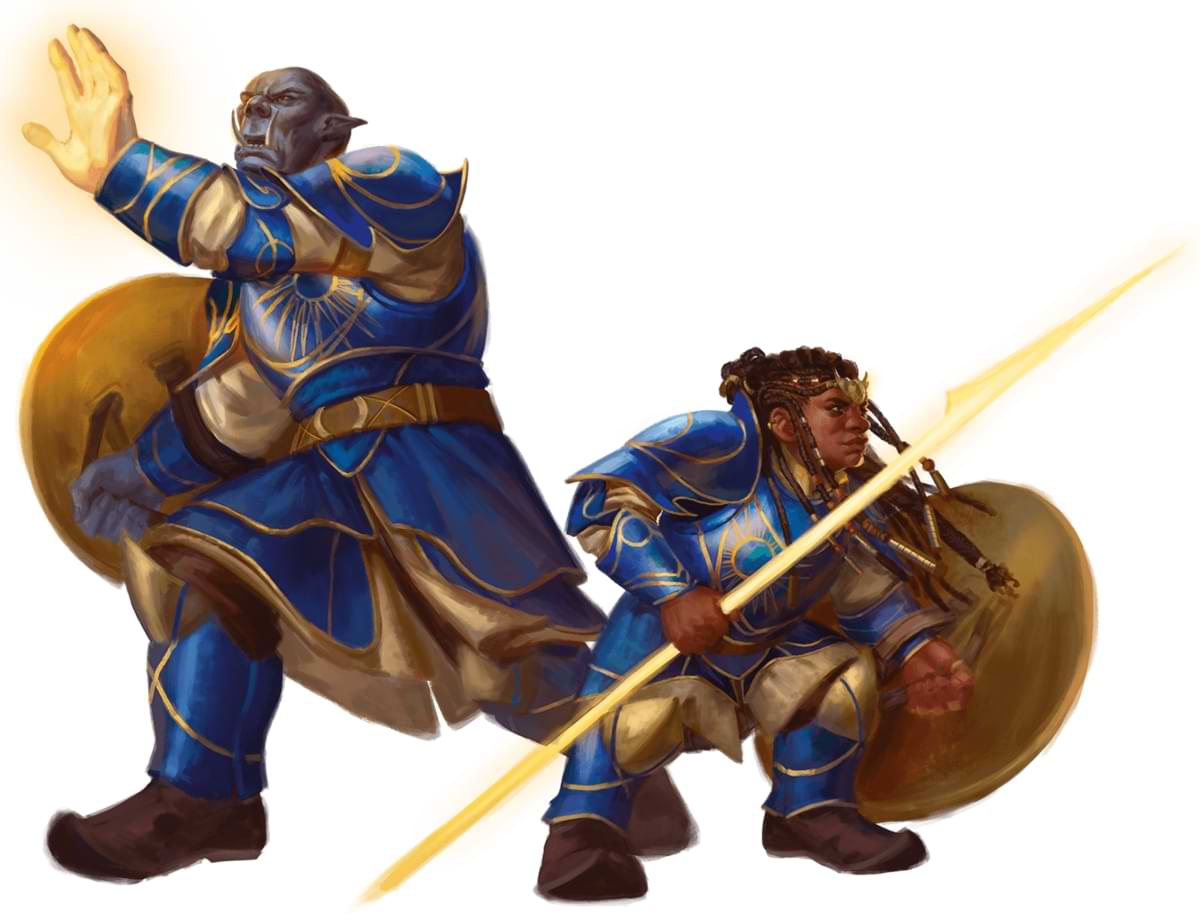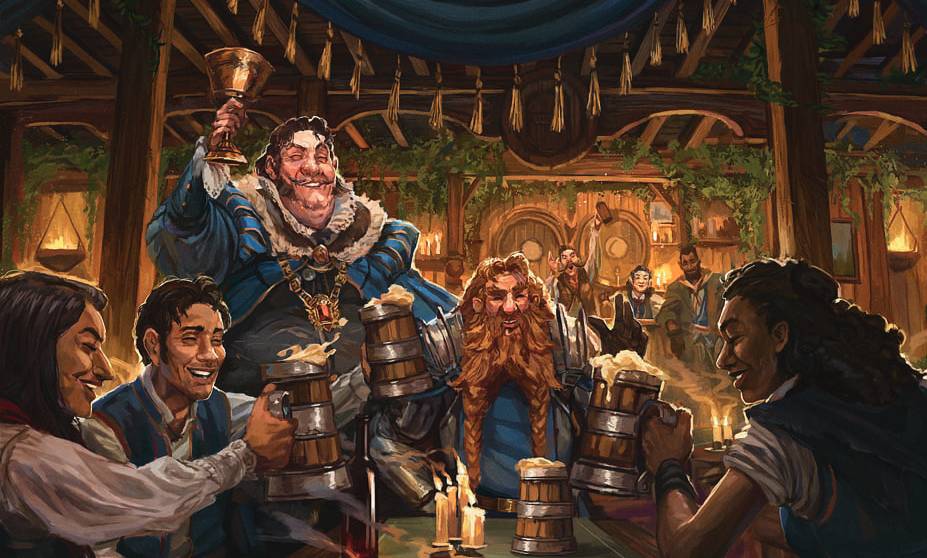Are you ready to smite the unholy, bless your allies, and alter reality? Good, because you’re a cleric, and you’re here to perform miracles!
Clerics are one of the most versatile classes in fifth edition, with 14 official subclasses available to choose from. But the cleric’s history causes many players to hear “cleric” and think “healer.” Understandably so—several domains help you specialize as a support caster. While healing is miraculous and vital, the cleric spell list can do so much more than that.
Below, we review 10 of our favorite spells for the 2014 cleric. With these spells, you can bend luck, restore allies, banish fiends, and ask your Dungeon Master silly questions.
- Bane / Bless
- Cure Wounds / Mass Cure Wounds
- Divination
- Greater Restoration
- Guidance
- Healing Word / Mass Healing Word
- Heroes’ Feast
- Revivify
- Spirit Guardians
- Spiritual Weapon
1. Bane / Bless
1st-level enchantment
We discuss bless in our "Best Spells for the 2014 Paladin" article, so let’s take this opportunity to look at its spiteful counterpart, bane. Where bless protects your party by providing a 1d4 bonus to attack rolls and saving throws, bane weakens your foes, imposing a 1d4 penalty to their attack rolls and saving throws if they fail a Charisma saving throw.
So, which should you use? Do you bless your friends to boost their luck, or do you bane your enemies, making them less likely to hit with an attack or resist magic? The answer may depend on the terrain, your allies’ fighting style, and the type of enemies you’re facing.
If your enemies are shooting arrows and not slinging spells, or if your spellcaster allies mostly use spells that require a saving throw, you may want to cast bane on your opponents. Conversely, if your allies are mostly martial combatants who would benefit from that boost to attack rolls, or your allies are frequently being forced to make saving throws to resist enemy effects, then you may prefer to bless them. Also keep in mind your enemy’s likely strengths and weaknesses; many undead and beasts are more likely to fail a Charisma saving throw than, say, a dragon.

2. Cure Wounds / Mass Cure Wounds
1st-level evocation / 5th-level evocation
If your friend’s arm isn’t supposed to be bending in that direction, use this straightforward healing spell to put things back where they should be. Cure wounds restores more hit points on average than its sibling, healing word, but you must use your action to physically touch the target.
When you reach higher levels, you’ll gain access to mass cure wounds, a potent healing spell designed to restore your entire party. Unlike its 1st-level counterpart, this spell can hit up to six creatures in a 30-foot-radius sphere centered anywhere within 60 feet of the caster. Throw some healing to your allies, then jump back behind cover!
3. Divination

4th-level divination
Put your DM on the spot! Sure, you can use divination to peer into the secrets of the cosmos and further the plot in a critical moment. But you can also use it to ask your deity, "Hey, so—these boots, what are we thinking? The lavender or the periwinkle?"
For a mere 4th-level spell slot, you can talk somewhat directly to a deity. To cast divination, ask a specific question about a goal, activity, or event in the next week, and the DM must offer "a truthful reply." The DM may still choose to be cryptic or vague, and the deity may respond through omens and signs rather than a voice in your character’s head. And, of course, you may alter the course of history in those seven days, changing the outcome from what your deity predicted.
4. Greater Restoration
5th-level abjuration
If you or an ally is suffering from a serious ailment, greater restoration can likely help. This spell cures the target of an effect reducing its maximum hit points, a curse, a level of exhaustion, a reduction to an ability score, or an effect that had charmed or petrified it. In addition, many unique monster abilities or spells (such as geas) explicitly say that they can be cured by this spell.
Keep in mind that this spell is pricey, at 100 gp per casting. So if you don’t need rejuvenative magic quite this potent, you may be better off with lesser restoration or remove curse.
5. Guidance
Divination cantrip
Those of us who have been playing Baldur’s Gate 3 may have gotten a little spoiled by this popular cantrip. Your cleric can cast guidance on any willing target by touching them, adding 1d4 to an ability check of their choice for the next minute. Just remember that this spell requires verbal and somatic components, which is to say it’s often clearly visible. Your DM may (very reasonably!) rule that you cannot cast guidance on an ally while they are talking to an NPC, for example.
When I first read the guidance spell, I foolishly scoffed at the value of 1d4. After playing a few sessions and watching several players fail an ability check by 4 or less, I reevaluated that take. The highest DC you’re likely to encounter is 25, so the chances that 1d4 might be all it takes to turn your roll from a failure into a success are higher than you might think! We play Dungeons & Dragons to tell a story, and helping your friend pass an Investigation or Stealth check could prove critical to that story.
Besides, what better use is there for magic than helping your friends succeed?
6. Healing Word / Mass Healing Word
1st-level evocation and 3rd-level evocation
"Hey! You’re…uh… you’re healed now!" And that’s all it takes!
Healing word allows you to use your bonus action to heal an ally within 60 feet of you. Use this spell instead of cure wounds if you need to heal an ally far away, or if you want to use your action to do something else. (If you need to use that action to help another ally, consider using a healer’s kit or casting the spare the dying cantrip.)
When you reach 5th level in cleric, you’ll be able to cast mass healing word, restoring hit points to up to six allies within 60 feet of you. If a tough enemy has knocked multiple allies unconscious, this spell can turn the tide of the encounter.
7. Heroes’ Feast

6th-level conjuration
You know it, you love it, you cast it before you enter a dragon’s lair or lich’s tower. Heroes’ feast is arguably the most powerful buff spell in fifth edition D&D. After eating this magical meal, you will be immune to poison and the frightened condition, your hit point maximum will increase by 2d10, and you will gain advantage on all Wisdom saving throws. (Just don’t forget its price tag of 1,000 gp per casting!)
Wisdom saving throws are one of the most common saving throws that monsters will force you to make. Many enemy abilities that can make you charmed require a Wisdom saving throw, as do common spells your party might face, like hold person or slow.
Perhaps most importantly, the spell is fun. Take this opportunity to describe the spectacular meal conjured by your magic!
8. Revivify
3rd-level necromancy
Imposing your will over the bounds of life and death is the cleric’s greatest expression of power. When an ally falls, your friends aren’t looking to you for a fireball. In that moment, a suggestion isn’t what will change history. Revivify will.
Revivify can bring the dead back to life if they have died within the last minute. It cannot, however, restore missing body parts or bring someone back if they've died of old age. If you’ve run out the clock or, even worse, an ally has been disintegrated, you will need more powerful magic such as true resurrection.
9. Spirit Guardians
3rd-level conjuration
Spirit guardians is another staple for many clerics, and for good reason. If you ever find yourself swarmed by minions, conjuring some spirit guardians to protect you and your allies is a great use of your concentration. They’ll create a protective 15-foot aura around you, dealing necrotic or radiant damage to any creature that starts their turn there or enters the area on their turn.
This is a great opportunity to be creative and express your character’s beliefs, story, or personality through their magic. Remember, you decide what your spirit guardians look like! Are you an infernal cleric, with ethereal imps circling you protectively? A priest of Bahamut, with little pseudodragons swooping down at your enemies? If your table is less serious, maybe you’re protected by a gaggle of geese or a collection of teddy bears!
10. Spiritual Weapon
2nd-level evocation
What’s a cleric without their spectral, floating greataxe? As a bonus action, you can summon a spiritual weapon anywhere within 60 feet of you. For up to 1 minute, that weapon will attack whatever foe you indicate if you use your bonus action to command it. This spell doesn’t require concentration, so you can combine it with spells that do, such as bane or spirit guardians. Also keep in mind that although you can’t cast two spells on a turn, using your bonus action to command an already-conjured spiritual weapon doesn’t count as casting a spell.
If you think your spiritual weapon is going to land most of its attacks (maybe the druid has cast faerie fire or the monk is knocking many enemies prone, or you just know that they have low AC), you may want to upcast this spell to 4th or even 6th level to deal more damage.
Again, this spell presents a great opportunity to be creative with your spellcasting. What form does your spiritual weapon take? If your deity is associated with a weapon, you can lean on that. But you could, of course, come up with something goofy like a lollipop. Or you could use the spell to nod to your character’s story, perhaps changing your spiritual weapon to match that of another character you’ve become close with.
Building a Cleric
Now that you’ve prepared some spells, it’s time to hop into D&D Beyond’s character builder! Once you’ve made your character, don some armor, grab that mace, and tell your friends to emotionally prepare for the possibility that you might not heal them every turn.
Damen Cook (@damen_joseph) is a lifelong fantasy reader, writer, and gamer. If he woke up tomorrow in Faerûn, he would bolt through the nearest fey crossing and drink from every stream and eat fruit from every tree in the Feywild until he found that sweet, sweet wild magic.








-
View User Profile
-
Send Message
Posted Jan 30, 2024I’d go for Aid, since it doesn’t just boost regular hit point maximum but gives those hit points. In a pinch, it can be use to bring multiple people up from zero in addition to its eight hour buff.
If we’re including expanded options from Tasha’s, Aura of Vitality is great and becomes even better if you grab meta magic extended spell, it’s an amazing after combat heal that doesn’t take as long as a short rest!
-
View User Profile
-
Send Message
Posted Jan 30, 2024Just to point out, it’s not been put second because the author thinks it’s the second best spell a cleric could have; it’s second because the list is alphabetical and Cure Wounds comes between Bane and Divination
-
View User Profile
-
Send Message
Posted Jan 30, 2024I hope they keep the updated version of Guidance being cast as a reaction to a failed check, that flows much better during play.
-
View User Profile
-
Send Message
Posted Jan 30, 2024So 5.1 or 5.5e but not 5e. Changing the moniker of the original and giving a new iteration the same old name is worse that irritating it is confusing.
-
View User Profile
-
Send Message
Posted Jan 31, 2024Then why not just say "5e"? :D
-
View User Profile
-
Send Message
Posted Jan 31, 2024Not sure why you'd rank cure wounds higher than healing word?
The extra healing is rarely worth it as it's all too easily lost; the focus of a healer should be on keeping allies in the fight, not topping them off, especially since there's literally no penalty for being hurt until you hit 0 hit-points. This is why healing word is vastly superior; it only takes a bonus action to revive someone at range and get them straight back into the fight; so what if they have a point or two less HP when one hit will take them down again anyway?
The dice roll only matters for a Life domain Cleric once they gain the ability to always max out the roll, but as a 17th-level ability most campaigns will never see that.
When it comes to topping off hit-points, short resting and prayer of healing are superior.
-
View User Profile
-
Send Message
Posted Jan 31, 2024Cure wounds? Really? Healing word's ugly and pathetic older brother who lives in their parents' basement until the age of 50? Get it out of here
-
View User Profile
-
Send Message
Posted Jan 31, 2024Wrong decade.
-
View User Profile
-
Send Message
Posted Jan 31, 2024Cure wounds is a terrible spell. Only 2 more HP of healing on average compared to Healing Word, takes an action compared to a bonus action and has a range of touch compared to 60 feet. Bad healing, bad action economy, bad range. Get in the bin.
-
View User Profile
-
Send Message
Posted Jan 31, 2024What is a 2014 cleric?
-
View User Profile
-
Send Message
Posted Jan 31, 2024Cleric under the original version of 5e, which was released in 2014. A revised version of 5e is being released later this year, and Wizards added the year to reduce confusion once the revision releases.
As has often been the case with their inconsistent terminology for the revised 5e, it clearly increased confusion for some folks.
-
View User Profile
-
Send Message
Posted Feb 1, 2024Real reason they call it the 2014 cleric? So you will think the stuff is old so you buy the new stuff. It's called a marketing ploy.
-
View User Profile
-
Send Message
Posted Feb 1, 2024One that has Disadvantage on visual Perception checks - it doesn't have 2020 vision ;)
-
View User Profile
-
Send Message
Posted Feb 2, 2024So just say 5E. They don’t say 1989 when referring to AD&D 2nd Edition or 2003 when referring to 3.5. They just sound foolish when they talk about 2014 [insert class here].
-
View User Profile
-
Send Message
Posted Feb 2, 2024I hope that this doesn't become a trend that 5e starts to get officially called ¨2014¨ D&D
-
View User Profile
-
Send Message
Posted Feb 2, 2024I think our group ends up playing it that way most of the time anyway. Players have a tendency to blurt out actions and roll checks before the cleric can say..."I cast guidance".
-
View User Profile
-
Send Message
Posted Feb 3, 2024Was this supposed to be for the 2024 cleric? Or a cleric 10 years ago?
-
View User Profile
-
Send Message
Posted Feb 3, 2024It’s not ranked, it’s alphabetical
-
View User Profile
-
Send Message
Posted Feb 3, 2024Cure Wounds isn't even worth memorizing in most games. Healing Word is far superior.
-
View User Profile
-
Send Message
Posted Feb 3, 2024what the hell is a 2014 cleric